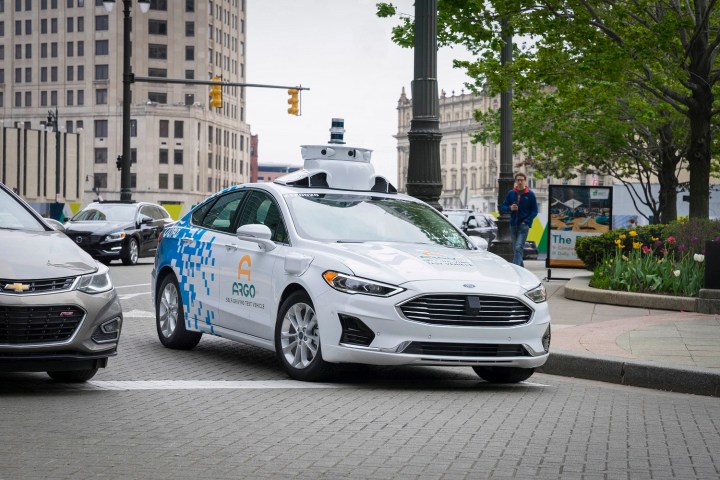
Pennsylvania-based self-driving car startup Argo A.I. revealed its third-generation autonomous car prototype on the streets of Detroit. The company, which received a $1 billion investment from Ford in 2017, explained it made comprehensive upgrades to the technology that helps its experimental sedan safely and reliably drive itself without any human input.
Argo A.I.’s test mule is based on the Fusion Hybrid; Ford invested a fortune in the company, so using a Volvo V60 presumably wouldn’t fly. It looks a lot like the previous prototypes, but Argo A.I. published a lengthy Medium post to explain the car is fitted with new technology that is one step closer to production. The updates included an upgraded sensor suite with new radars and cameras that detect objects further away than previously possible. That means if you cross the street in front of the car, its camera will generate a digital image of you using about a dozen pixels instead of one or two in Argo’s last-generation technology. In turn, the car has a better chance of knowing you’re a pedestrian, not a fire hydrant.
Detecting obstacles is useless if the car is unable to interpret what it sees. To that end, Argo A.I. designed a new computing system with more processing power. The car’s brain is also smaller in physical size, quieter, and cooler. Generating less heat and emitting less noise makes riding in the autonomous Fusion a much more comfortable experience. Finally, like competitor Uber, Argo A.I. fitted backup systems that keep the car moving (or, depending on the situation, bring it to a stop) if one of the primary systems fail for any reason.
Detroit residents will soon see the Fusion Hybrid-based prototype navigating its way through town. Argo is looking forward to finding out how its technology performs on the streets of the nation’s Motor City, where no two streets are alike. Some are wide; others are narrow. Some are marked; others aren’t. Many are under construction, and we hope the Fusion won’t plow through someone’s fence when it first encounters snow.
Argo A.I.’s third-generation self-driving cars will also be deployed on the streets of Pittsburgh, Miami, Washington D.C., and Palo Alto, California. Could Wolfsburg, Germany, join the roster sooner or later? Possibly.
Volkswagen may soon help Ford and Argo A.I. make self-driving cars a reality. The company put an end to its relatively brief partnership with Amazon-backed Aurora, one of Argo’s rivals, and insiders revealed it’s preparing to join Ford — which it already develops commercial vehicles with — in a bid to boost Argo to superstar status in the self-driving car world. The three companies want to take Alphabet’s Waymo division head-on.
If the trio agrees on the terms of collaboration, the alliance could be made public before the end of the summer.
Editors' Recommendations
- Tesla Autopilot vs. full self-driving: What’s the difference?
- Volkswagen is launching its own self-driving car testing program in the U.S.
- Apple’s rumored car could cost the same as a Tesla Model S
- Tesla hopes full self-driving beta will be out globally by the end of 2022
- We tested the self-driving Mercedes tech so advanced, it’s not allowed in the U.S.




